Britain's struggles in nuclear race
- Published
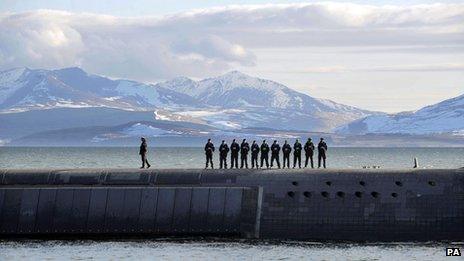
HMS Vanguard carried out the first Trident missile test in 1994
The Trident report that is about to be unveiled is just the latest twist in what has been a long saga of Britain's efforts to become and remain a member of the exclusive nuclear weapons club.
For much of the Cold War, the aim of successive British governments was to have a capability that mirrored in quality, if not in size, the arsenals of the superpowers.
The first stumbling block was the shock US decision to halt nuclear co-operation with Britain at the end of World War II. From being partners in the fabled Manhattan Project, Britain was left initially largely to its own (nuclear) devices.
But the then Labour Foreign Secretary, Ernest Bevin, declared that Britain had to have a nuclear weapon with a "bloody Union Jack on top of it".
Britain did become the third country, after the US and the Soviet Union, to test an atomic device, in October 1952. But just 17 months later, the Americans detonated their first, much more powerful thermonuclear device - or hydrogen bomb - at Bikini Atoll.
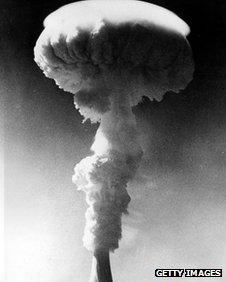
Britain tested its first H-bomb in 1957
The race to catch up was on again.
The British began a new series of tests based on Christmas Island in the Pacific in May 1957. After the first test, the government proudly proclaimed that Britain, too, had become a thermonuclear power.
But that, it turned out, was a bluff, in order not to undermine the perception of Britain as a first-rate power. The explosive power of the initial devices was disappointing, and they were not H-bombs in the accepted sense - they were fission rather than fusion bombs.
It would not be until 1961 that the British possessed an operational H-bomb.
Ironically, the advent of the H-bomb era fired up the anti-nuclear movement. In the late 1950s and early 1960s, the Campaign for Nuclear Disarmament was able to mobilise hundreds of thousands of people on marches to "ban the bomb". The issue was at the centre of British politics.
Nowhere else to go
There was also another challenge for the military: how to deliver its nuclear weapons. This was another area where the British at times struggled to keep up.
During the 1950s, the RAF developed its legendary V-bombers - the Valiant, Victor, and Vulcan - in their iconic Cold War white, anti-flash colour scheme. But it soon became clear that they would increasingly struggle to get through Soviet air defences.
Initially, the answer was to fit the bombers with a British-designed stand-off missile, Blue Steel. But that was only an interim solution. For the longer term, the British turned to the Americans and the Skybolt ballistic missile that they were developing to equip their bomber force.
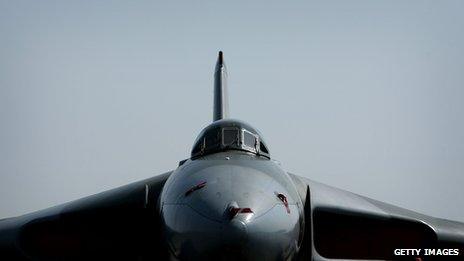
The Vulcan bomber was a deterrent in the Cold War
But then, another shock. In November 1962, the Kennedy administration decided to scrap Skybolt. It only informed the British after the decision was made.
The move left the British in an acute dilemma.
They had already scrapped their own ballistic missile programme, Blue Streak. They had nowhere else to go if they were to stay in the top rank of nuclear powers.
So the then Prime Minister, Harold Macmillan, rushed to Nassau to meet President Kennedy. The result of that meeting was a US agreement to sell Britain submarine-launched Polaris ballistic missiles. Britain would build its own submarines and the missile warheads.
That decision set the course for Britain's nuclear weapons capability ever since.
But again, within a few years, it became clear that Polaris would struggle to meet "the Moscow criterion" - the ability to breach the Soviet capital's improving missile defences.
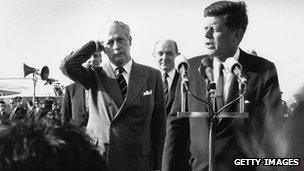
President Kennedy and Prime Minister Macmillan agreed Britain would build its own nuclear warheads
The British answer was a secret and, as it turned out, hugely expensive warhead improvement programme called Chevaline. There was huge controversy when it was finally made public in the early 1980s.
The Trident programme, to replace Polaris, was also already in its early stages by then. It followed the model of its predecessor - American missiles, British submarines and warheads.
But, by the time the first British Trident submarine went on patrol in 1994, the Cold War was over.
'Bargain'
Trident is now Britain's only nuclear weapon. It retired its last free fall bombs in 1998. And the stockpile of operational Trident warheads is also much reduced from its original level.
For the British military, even some of the clouds that have loomed over its efforts to be a big nuclear player have had silver linings.
Despite the setbacks, there were elements of its early H-bomb designs that so interested the Americans they helped cement US-UK nuclear co-operation.
The Polaris programme was also a remarkably successful undertaking for the Royal Navy. From the US agreement to sell Britain the weapon in December 1962 to the first submarine going on patrol was less than six years - an astonishing technical achievement.
The navy has also undertaken more than 300 continuous Polaris or Trident patrols since then - with just four submarines at a time available.

The first Polaris patrol took place in 1968
And despite the controversies over the cost, the advocates of both Polaris and Trident argue that they have actually been a bargain for what they deliver.
Whether there is a need to continue with that capability - to have at least one submarine always on patrol - is now at the heart of the arguments over the future of the British nuclear capability.
The backdrop is a world in which the Cold War is history and there are very different security challenges looming, while resources are stretched in what looks like a prolonged era of austerity.
But new fears of nuclear proliferation and uncertainties about future instability have provoked a new debate on what kind of nuclear force, if any, the country should continue to deploy.
- Published23 May 2017
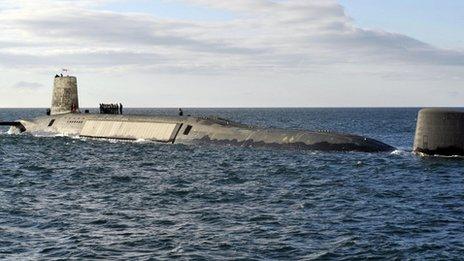
- Published15 July 2013
